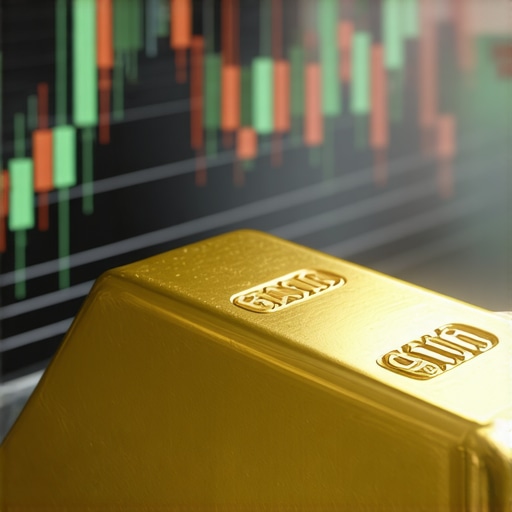Understanding Gold Demand Trends: A Key to Strategic Investment
Investing in gold has long been regarded as a safe haven during economic uncertainty. As the world shifts through various financial climates, understanding gold demand trends becomes crucial for making informed investment decisions. Analyzing these trends allows investors to anticipate market movements, capitalize on opportunities, and mitigate risks associated with gold investments.
The Impact of Global Events on Gold Demand
Global events such as geopolitical tensions, economic downturns, and changes in monetary policy significantly influence gold demand. For instance, during times of crisis, the demand for gold typically increases as investors seek security. Understanding how these events correlate with gold prices can enhance your investment strategy. By keeping an eye on global supply and demand factors, you can be better prepared to act during market fluctuations.
Analyzing Historical Trends for Future Insights
Historical data provides invaluable insights into gold demand trends. By analyzing past price movements and demand patterns, you can identify potential future behaviors. Factors such as inflation rates, currency strength, and interest rates have historically impacted gold prices. For example, as inflation rises, gold often serves as a hedge against currency devaluation. Thus, understanding these dynamics is essential for effective gold investment strategies.
Seasonal Patterns in Gold Demand
Gold demand is not only influenced by global events but also by seasonal patterns. Festivals and wedding seasons in various cultures lead to increased gold purchases. In countries like India, the demand typically spikes during festival seasons, affecting global gold prices. By recognizing these seasonal trends, investors can time their purchases more effectively, maximizing potential returns.
Technological Advances and New Investment Vehicles
As technology evolves, new investment vehicles such as gold ETFs have emerged, making it easier for investors to access gold markets. These financial products can reflect shifts in demand and provide a diversified approach to investing in gold. Understanding the characteristics and benefits of these products is vital for modern investors looking to enhance their portfolios.
Conclusion: Staying Ahead of the Gold Market
In conclusion, analyzing gold demand trends is essential for strategic investing. By understanding the impact of global events, historical data, seasonal patterns, and technological advancements, investors can make informed decisions that align with market movements. For those looking to delve deeper into gold investing, exploring topics such as gold price trends and market dynamics will further enhance investment strategies and outcomes.
Exploring the Role of Central Banks in Gold Demand
Central banks play a pivotal role in shaping gold demand trends. Their decisions regarding gold purchases or sales can significantly influence market perceptions and prices. In recent years, many central banks have increased their gold reserves, viewing it as a hedge against economic instability and inflation. Keeping track of these central bank activities can provide investors with critical insights into potential market movements. For a deeper understanding, explore how central bank purchases affect gold investment.
Geopolitical Factors Impacting Gold Prices
The geopolitical landscape is another crucial determinant of gold demand. Events such as trade wars, conflicts, and diplomatic tensions can lead to increased gold buying as investors seek refuge from uncertainty. When geopolitical tensions rise, the demand for gold often surges, driving prices upwards. By staying informed about global politics, investors can better anticipate fluctuations in gold prices and adjust their strategies accordingly.
The Influence of Economic Indicators on Gold Investment
Economic indicators such as GDP growth, employment rates, and consumer confidence directly impact gold demand. During periods of economic downturn, gold typically sees a rise in demand as investors flock to safe-haven assets. Conversely, in a robust economy, demand may wane as investors explore riskier assets. Understanding these economic signals is essential for investors aiming to navigate the complexities of gold markets effectively. For comprehensive strategies, consider reading fundamental gold investment strategies for 2025.
Understanding Gold Investment Strategies
Implementing effective gold investment strategies requires a nuanced understanding of market dynamics and trends. Whether you are considering physical gold, ETFs, or mining stocks, each investment vehicle has distinct advantages and risks. For instance, while physical gold offers security, ETFs provide liquidity and ease of trading. By evaluating your investment goals and risk tolerance, you can choose the right approach for your portfolio.
Evaluating Gold Mining Stocks
Investing in gold mining stocks can be an attractive option for those looking to maximize returns. These stocks often correlate with gold prices but can provide additional leverage due to operational efficiencies and production capabilities. However, it’s crucial to assess the specific mining company’s health, including its operational costs, management, and geopolitical risks associated with its locations. To learn more about this investment avenue, refer to understanding gold mining stocks: pros & cons.
Gold ETFs: A Modern Investment Approach
Gold ETFs have revolutionized the way investors access gold markets. These investment funds allow individuals to invest in gold without the need for physical storage. By tracking the price of gold, ETFs offer a practical solution for diversifying a portfolio. Understanding the characteristics and benefits of gold ETFs is essential for modern investors looking to capitalize on gold’s potential. For more details, check out understanding gold ETFs: characteristics & benefits.
Conclusion: Making Informed Decisions in Gold Investing
In conclusion, understanding gold demand trends and the various factors influencing them is crucial for making informed investment decisions. By analyzing central bank activities, geopolitical events, and economic indicators, investors can better position themselves in the gold market. Moreover, exploring different investment strategies, such as gold mining stocks and ETFs, can further enhance your portfolio. Equip yourself with knowledge and stay ahead of the trends for a successful gold investment journey.
Identifying Key Trends in Gold Investment
As the gold market evolves, staying informed about key trends is essential for successful investments. One prominent trend is the increasing interest in gold as a hedge against inflation. With economic uncertainty looming, many investors are turning to gold to safeguard their wealth. Understanding these trends can help you make strategic decisions. For instance, you can learn more about gold price trends and how they can impact your investment strategy.
The Rise of Gold Mutual Funds
Gold mutual funds are gaining traction among investors looking for a diversified approach to gold investment. These funds pool resources to invest in gold-related assets, providing exposure to gold prices without the need to own physical gold. This investment vehicle can be particularly attractive for those who prefer professional management of their portfolios. To understand the advantages, read about the advantages of investing in gold mutual funds.
Gold Futures: A Flexible Trading Option
Gold futures offer investors the flexibility to speculate on gold prices without the need to own the physical commodity. This trading strategy allows you to leverage your investment, potentially amplifying returns. However, it also comes with increased risk. If you’re new to this market, you might want to explore gold futures explained – strategies for beginners for a comprehensive understanding of how to navigate this investment option.
Risk Management in Gold Investment
Effective risk management is crucial in the volatile gold market. Diversifying your gold investments can help mitigate risks associated with price fluctuations. Consider incorporating a mix of physical gold, ETFs, and mining stocks to create a balanced portfolio. Additionally, keeping abreast of global economic indicators can provide insights into potential market shifts. To learn about the essential tips for new gold investors, visit top 5 essential gold investment tips for smart investors.
Understanding Market Sentiment
Market sentiment plays a significant role in gold prices. When investors are optimistic about the economy, gold demand may decrease as they seek higher returns in equities. Conversely, during economic downturns, gold often shines as a safe-haven asset. Monitoring news and sentiment indicators can help you anticipate changes in demand and adjust your investment strategies accordingly. For more in-depth insights, check out gold demand trends: essential insights for investors.
Conclusion: Adapting to the Evolving Gold Market
In conclusion, adapting to the evolving gold market involves understanding the various investment vehicles available, recognizing key trends, and implementing effective risk management strategies. Whether you choose to invest in physical gold, ETFs, or mutual funds, staying informed about market dynamics will empower you to make informed decisions. Equip yourself with knowledge and remain vigilant about the factors influencing gold prices to maximize your investment potential.
Exploring Alternative Gold Investment Avenues
In addition to traditional investments in physical gold and ETFs, there are various alternative avenues worth exploring. For instance, investing in gold mining stocks can provide exposure to the gold market while potentially offering higher returns. These stocks are influenced not only by gold prices but also by the operational efficiency of mining companies. To understand the pros and cons of this strategy, check out understanding gold mining stocks: pros & cons.
The Role of Gold IRAs in Diversification
Gold IRAs (Individual Retirement Accounts) are another effective way to diversify your retirement portfolio. By including physical gold in your retirement plan, you can hedge against inflation and market volatility. This investment strategy can help ensure a more secure financial future. If you’re interested in learning more about this option, visit understanding gold IRAs: a powerful investment choice.
Understanding Global Economic Influences on Gold Prices
Global economic factors significantly impact gold prices, making it essential for investors to stay updated on current events. Factors such as geopolitical tensions, currency fluctuations, and interest rates can all lead to price volatility. Understanding how these elements interact can enhance your investment strategy. For deeper insights into how gold prices are affected by global supply and demand, check out how gold prices are affected by global supply and demand.
Leveraging Gold Trading Techniques
For those looking to maximize their returns, employing smart gold trading techniques is crucial. Investors can benefit from strategies such as swing trading or day trading to capitalize on short-term price movements. These techniques require a solid understanding of market trends and technical analysis. To learn more about effective trading methods, explore top gold trading techniques for successful investments.
Conclusion: Embracing a Holistic Approach to Gold Investment
In conclusion, a holistic approach to gold investment encompasses understanding market dynamics, exploring various investment vehicles, and implementing robust trading strategies. By diversifying your portfolio with options like gold mining stocks, gold IRAs, and advanced trading techniques, you can enhance your potential for long-term success in the gold market. Stay informed and adapt your strategies to navigate the evolving landscape of gold investment effectively.
Frequently Asked Questions about Gold Investment
1. What are the benefits of investing in gold?
Investing in gold offers several benefits, including a hedge against inflation, portfolio diversification, and a safe haven during economic uncertainty. Additionally, gold has intrinsic value and is considered a reliable asset in times of market volatility.
2. How can I invest in gold?
You can invest in gold through various methods, such as buying physical gold (like coins and bars), gold ETFs, gold mining stocks, or gold IRAs. Each method has its own advantages and risks, so it’s essential to choose the one that aligns with your investment goals.
3. What are gold IRAs and how do they work?
Gold IRAs are specialized retirement accounts that allow you to hold physical gold and other precious metals. These accounts provide tax advantages while diversifying your retirement portfolio. To set up a gold IRA, you must work with a custodian who specializes in these types of investments.
4. How do global events affect gold prices?
Gold prices are influenced by various global events, including geopolitical tensions, economic data releases, currency fluctuations, and changes in interest rates. Investors often look to gold as a safe asset during uncertain times, leading to increased demand and higher prices.
5. What is the difference between gold bullion and gold coins?
Gold bullion typically refers to gold bars or ingots, which are valued based on their weight and purity. Gold coins, on the other hand, can carry numismatic value in addition to their gold content. Coins may be more collectible and can have higher premiums over spot gold prices.
6. Can I use gold as collateral for loans?
Yes, gold can be used as collateral for loans. Many lenders will accept physical gold as security to back a personal loan or a pawn loan. However, the loan amount is often a fraction of the gold’s market value.
7. Are there risks associated with investing in gold?
Yes, like any investment, gold carries risks. These include price volatility, storage costs for physical gold, and potential regulatory changes affecting gold markets. It’s crucial to conduct thorough research and consider these factors before investing.
8. How can I determine the best time to invest in gold?
Determining the best time to invest in gold involves analyzing market trends, economic indicators, and geopolitical events. Monitoring factors such as inflation rates, interest rates, and currency strength can help you make informed decisions about when to enter the gold market.
9. What are the tax implications of investing in gold?
The tax implications of investing in gold depend on how you invest. Profits from selling physical gold or gold ETFs may be subject to capital gains tax. It’s advisable to consult a tax professional to understand how gold investments will impact your tax situation.
10. Where can I learn more about gold investment strategies?
To learn more about gold investment strategies, consider trusted financial websites, books on personal finance, or consulting with a financial advisor. Resources like Buying Gold Now provide valuable insights and guidance on gold investing.
Authority Resources for Gold Investment
For those looking to delve deeper into gold investment strategies and market analysis, several authoritative resources can provide valuable information:
- World Gold Council – A leading authority on gold, offering research and insights on the gold market.
- Investopedia – An educational platform that covers various aspects of investing, including comprehensive guides on gold investments.
- Kitco Metals – A trusted source for real-time gold prices and market analysis.
- MarketWatch – Provides news and insights into financial markets, including updates on gold prices and investment trends.
- Forbes – Features articles on finance and investment strategies, including insights into gold investment.
Conclusion: Your Path to Successful Gold Investment
In summary, investing in gold can be a rewarding journey when approached with the right knowledge and strategies. By understanding the various avenues for investment, the impact of global economics, and the importance of diversification, you can position yourself for success in the gold market. Stay informed, leverage credible resources, and continuously adapt your strategies to make the most of your gold investment endeavors.











What struck me about this analysis is how pivotal global events are in shaping gold demand. Living through recent geopolitical tensions, I’ve noticed a tangible spike in gold interest among investors, which aligns perfectly with the idea of gold as a safe haven during uncertain times. However, one challenge I’ve encountered is timing investments during these fluctuating periods, especially when market sentiments can shift rapidly due to news cycles. I find that relying solely on historical data can sometimes miss the nuance of real-time political developments that influence gold demand almost instantly.
Also, the seasonal demand aspect, especially around cultural festivals such as those in India, adds another layer of complexity for global investors. It’s fascinating how local consumer behavior significantly affects worldwide prices. I wonder how investors who are not based in these key markets incorporate such seasonal trends into their strategies?
Moreover, with innovations like gold ETFs making entry easier, there’s a broader participation base, but I’ve also questioned how much these vehicles reflect or amplify the underlying physical demand versus speculative trading.
Has anyone tried balancing these global event-driven strategies with seasonal trend observations or leveraged both physical and ETF holdings to manage risks effectively? I’d love to hear about practical approaches that have worked in such a multifaceted market environment.
Responding to Clara’s insightful comment, I can say from experience that blending data on global events with awareness of seasonal demand cycles is indeed challenging but rewarding. For instance, I found monitoring central bank gold purchases particularly useful since these moves often signal longer-term trends beyond immediate geopolitical shocks. Combining that with tracking gold demand spikes during festivals or wedding seasons in India, as the post mentions, has helped me better time acquisitions or diversifications.
Regarding the question about balancing physical gold and ETFs, I’ve found a hybrid approach to be effective. Physical gold offers the tangible security and inflation hedge especially valued during volatile times, while ETFs provide liquidity and easier portfolio rebalancing. However, being mindful that ETFs can be influenced by speculative flows is critical; therefore, I monitor ETF volumes alongside physical demand reports to gauge real market sentiment.
I’m curious how others integrate economic indicator signals, like inflation and interest rates, with these event-driven and seasonal strategies. How do you balance immediate news impact with longer-term fundamental trends when making investment moves in gold?